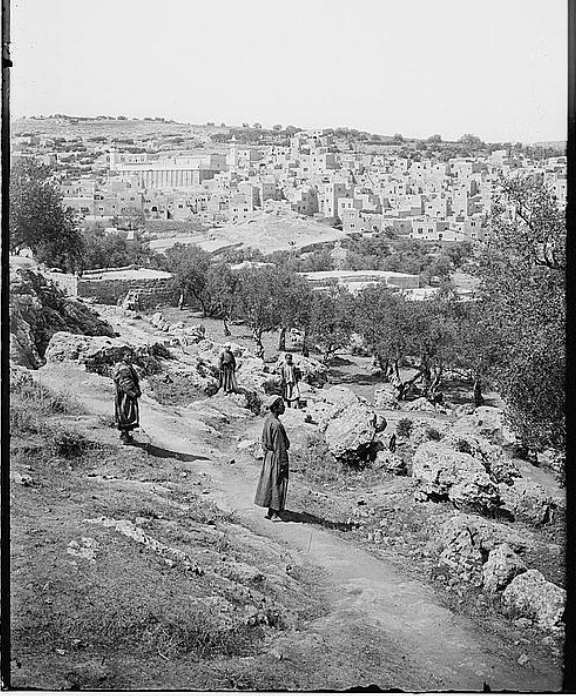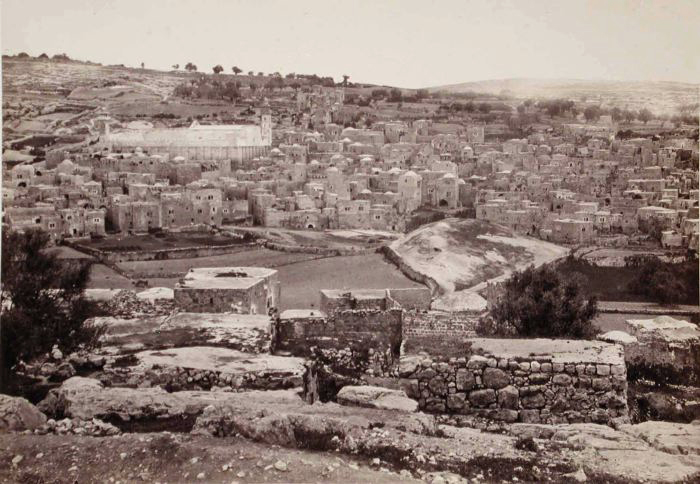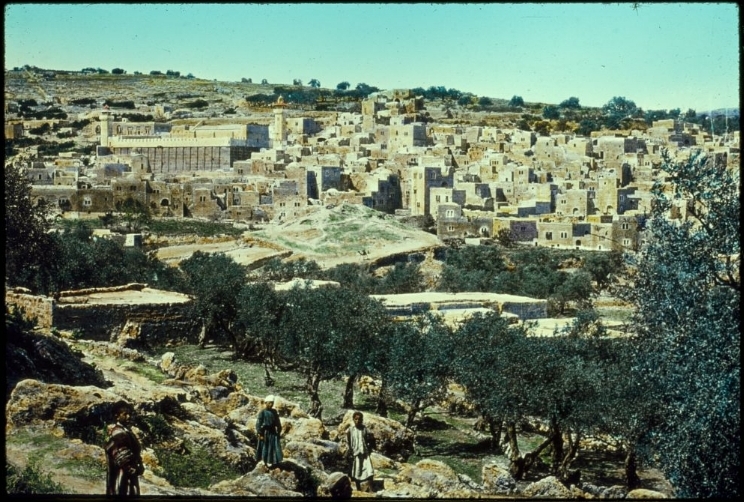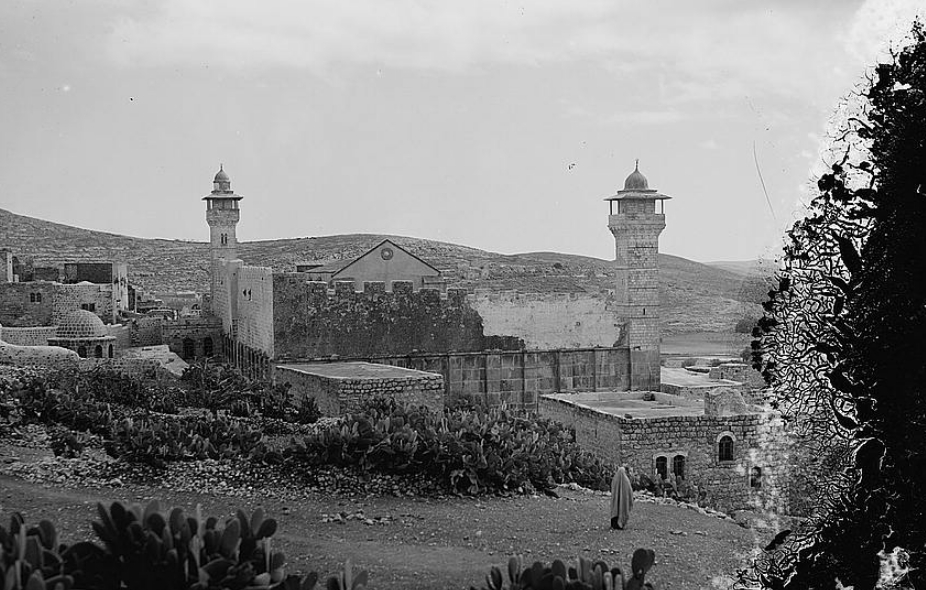|
Other Archaeological Sites / The Neolithic of the Levant (500 Page Book Online) Ancient Canaanite and Biblical Hebron (Tel Rumeida) in Israel
Preface: Undoubtedly confusing in some instances is this subject matter as the dates of historical events differ from source to source and biblical scholars are not agreed on for instance who was in control of the Hebron area during the time of Abraham --- Hittites or Amorites (etcetera) ...
The Arabic term derives from the Quranic epithet for Abraham or Khalil al Rahman which means literally "Friend of God". Arabic Al Khalil thus precisely translates the ancient Hebrew toponym (place name) Ḥebron understood as ḥaber or friend (6). The earliest signs of settlement were on the Chalcolithic and Early Bronze Age I site centered on Tel (mound) Rumeida. Hebron was a Canaanite royal city when Abraham arrived there to settle. With the exception of Jerusalem, there is no other ancient city more important in Biblical tradition than Hebron (5). The Biblical Hebron is a city in Eretz Israel 19 miles south of Jerusalem in the Judean Hills 3050 feet above sea level. It is one of the oldest continuously inhabited communities in the world and was founded seven years before Zoan [Tanis] (1) in Egypt (Numbers 13:22) in the 18th century BC (circa 1725 BCE). The Bible first mentions Hebron in connection with Abraham and the cave of Machpelah. After Abraham departed from his nephew Lot he moved his tent and settled at the oaks (terebrinths) in the plain of Mamre (5).
Genesis 13:18 Then Abram removed his tent and came and dwelt in the plain of Mamre, Abraham approached the Hittites to buy the field owned by Ephron to bury his wife Sarah. Genesis 23:1 And Sarah was an hundred and seven and twenty years old: these were the years of the life of Sarah 2 And Sarah died in Kirjatharba; the same is Hebron in the land of Canaan: and Abraham came to mourn for Sarah and to weep for her 3 And Abraham stood up from before his dead and spake unto the sons of Heth (Hittites) saying 4 I am a stranger and a sojourner with you: give me a possession of a burying place with you that I may bury my dead out of my sight Genesis 23:17 ¶ And the field of Ephron [the Hittite] which was in Machpelah (Hebrew double tombs or later Patriarchs), which was before [to the east of] Mamre; the field and the cave which was therein and all the trees that were in the field, that were in all the borders round about, were made sure [18] Unto Abraham for a possession in the presence of the children of Heth before all that went in at the gate of his city 19 And after this Abraham buried Sarah his wife in the cave of the field of Machpelah before Mamre: the same is Hebron in the land of Canaan Then under Joshua’s leadership the Israelites attacked and conquered Hebron itself. The clan of Caleb was the force that captured the Canaanite city and then settled in it (5). Joshua 14: Hebron therefore became the inheritance of Caleb the son of Jephunneh the Kenezite unto this day, because that he wholly followed the Lord God of Israel. 15 And the name of Hebron before was Kirjatharba; which Arba was a great man among the Anakims. And the land had rest from war By King David’s time Hebron was an important city in Judah. It was therefore a natural place for God to send David to be acknowledged as King of Judah (Hebrews) (2 Samuel 2:1-4). Two years later David was acclaimed king of a united Judah and Israel (the United Monarchy or Kingdom of Israel), again in Hebron (2 Samuel 5). He reigned at Hebron for seven years and a half before moving his capital to Jerusalem (10). Excerpt: [While] in battle with the Philistines far to the north at Mount Gilboa Saul’s [late 11th century BCE] sons were killed by the enemy and Saul took his own life. David proceeded quickly to the ancient city of Hebron in Judah where the people of Judah declared him king (1010 BC). Once David and his men overpowered the remaining pockets of opposition among Saul’s supporters, representatives of all the tribes duly convened in Hebron to declare David king over all Israel. [Therefore] after reigning seven years in Hebron David moved north to conquer the [Canaanite] Jebusite stronghold [the original City of David and later the greater Jerusalem area] -- until then claimed by none of the tribes of Israel -- to make it his capital (1003 BC) [Page 126 in 2]. Insert: David the Second King of Israel established Jerusalem as its national capital. Before then Hebron had been the capital of David's Judah and Mahanaim of Ishbaal's [last remaining son of Saul; reigned two years only] Israel; and before that Gibeah had been the capital of the United Monarchy under Saul (*). And finally during the time of Judah Maccabee (164 BCE) and the Hasmonean Dynasty we have from the Apocrypha: First Maccabees Chapter 5:65 Then Judas and his brothers went out and attacked the Edomites in the land toward the south; he took Hebron and its villages and he destroyed its strongholds and burned the towers around it Biblical Time Line: (Page 221 3)
2091 BCE; Abraham leaves Haran; Sojourns to Canaan and settles in land around Tel Rumeida [toponym Hebron] (9) 2029 BCE; Abraham purchases the field and cave of (Hebrew) Machpelah from Ephron the Hittite (9) 1400 BCE; Beginning of the invasion and conquest of Canaan according to the Bible; Joshua leads Tribes of Israel (9) 1395 BCE; Caleb Inherits Hebron from Joshua While In Gilgal at at 85; Clan of Caleb occupies Hebron (Joshua 14:6-14) --- Julian Day Number: 1212148.75 = September 6, 1395 (9) 1010 BCE; David is anointed King of Judah and later of the United Monarchy at Hebron 701 BCE; Assyrian Sennacherib besieges Judah and deports its citizens to Mesopotamia 586 BCE; First Temple destroyed by the Neo-Babylonians; Edomites settle Hebron area. 539 BCE; Return to Zion from the Babylonian exile (597-539 BCE). 164 BCE; Hasmonean Revolt. Judah Macabee conquers Hebron. 30 BCE; Construction of Tomb of the Patriarchs over Machpela Cave. 70 CE; Temple, Jerusalem, Hebron destroyed.
Until 1964 Tel Rumeida had never been excavated. The great Biblical archaeologist William Foxwell Albright surveyed the site in the 1920s. The American expedition to Hebron, directed by Philip Hammond of Princeton Theological Seminary, excavated the site for three summer seasons in 1964 -- 1965 and 1966. Avi Ofer of Tel Aviv University excavated at the site between 1984 and 1986. This was followed by a salvage excavation on the north side of the tell in 1999 headed by veteran Israeli archaeologist Emanuel Eisenberg of the Israel Antiquities Authority. (5). The archaeological site called Tel (mound) Rumeida is located on a slope descending eastward from Jebel (Hill) Rumeida about a thousand yards west of the Tomb of the Patriarchs. It rises prominently above the surrounding buildings in the center of the modern city of Hebron (4). The excavations conducted over the years at the site indicate that human settlement in the area had begun in the fourth millennium BCE during the Chalcolithic period and the early Bronze Age I. The first expanded settlement at the site is dated to the early Bronze Age III (2700-2300 BCE). A fortified settlement was discovered with an area spanning approximately 30 dunams [7.4 acres] (4). But this settlement was destroyed and burned in about 2300 BCE. Since no ancient written references to the Early Bronze city exist we do not even know its name nor anything about its inhabitants (5). Five hundred years later in about 1800 BCE Canaanites settled at Hebron. A new and much higher city wall was erected during the Middle Bronze Age II (1750–1650 BCE) following the line of the older and lower Early Bronze wall (5). The city rebuilt in the Middle Bronze Ages I-II (2000-1600 BCE). At the time the city was surrounded by a massive wall of hewn stone and an external glacis which supported the wall. These impressive fortifications underline the importance of the city during this time. Further evidence to this effect is a cuneiform tablet with a cuneiform script discovered at the site which attests to an independent system of governance that had maintained commercial relationships with the surrounding kingdoms (4). The succeeding archaeological period at Hebron -- the Late Bronze Age (1550–1200 BCE) -- is especially intriguing because until recently it was thought that there was no evidence of Late Bronze Age occupation there. Hammond had found remains of Late Bronze Age occupation in six different areas. Hebron was in fact an active city during the Late Bronze Age particularly in Late Bronze II. In some cases Hammond determined that houses built in the Middle Bronze Age continued to be used in the Late Bronze Age as shown by the pottery found in them (5). All in all the evidence is strong that Hebron was a thriving city in the Late Bronze Age just before the time the Bible says the Israelites captured it (ibid). The material culture at Hebron during Iron Age I (1200–1000 BCE) was similar to other Iron I sites in the country that are identified with the earliest Israelites. The pottery includes fragments of collared-rim jars that are often associated with the early Israelites (ibid). The beginning of David’s reign is generally dated to about 1000 BCE, the transition point from Iron Age I to Iron Age II. At this time Hebron was not only walled and occupied its thriving population seemed to be growing (ibid). Although Sennacherib in 701 BCE was unable to capture Jerusalem he boasted of having destroyed 46 walled cities in Judah. Hebron was surely one of them. Its citizens were part of over 200,000 Judeans Sennacherib claims to have deported to Mesopotamia (ibid). Hebron revived again later in the seventh century BCE but it was again savaged by Babylonian forces in 589 BCE (Neo-Babylonian Nebuchadnezzar II destroyed the Judah Kingdom completely in 586-9 BC). Its 1100-year-old city wall was pried apart and pushed over (ibid). Hebron again revived in the Hellenist and early Roman periods (350 BCE-1st century CE). Private dwellings from that period were found at the site. That settlement came to an end in the latter part of the 1st century CE. During this time Hebron was called Idoma (4).
Supplement: International Standard Bible Encyclopedia (8)
III: Hittites of Palestine -- This [later] Assyrian and Babylonian usage has nothing to do with the earlier Old Testament listing of the Hittites as one of the seven nations in Canaan overthrown by the Israelites under Joshua (Deuteronomy 7:1). The identity of these Hittites presents an unsolved problem. They appear as inhabitants of the central hill country (Numbers13:29). In Genesis 23:3-20 they are the native population of the Hebron district, “the people of the land" among whom Abraham lives as “a stranger and a sojourner" and from whom he buys the field containing the cave of Machpelah as a family burying place. It is scarcely satisfactory to treat "Hittites" in these contexts as simply the designation for the native population when we consider other references to Hittites in Canaan in conjunction with, but in distinction, from other ethnic groups. Jerusalem according to Ezekiel 16:3 had a mixed Hittite and Amorite foundation. And say, Thus saith the Lord GOD unto Jerusalem; Thy birth and thy nativity is of the land of Canaan; thy father was an Amorite and thy mother an Hittite Addendum: This is indeed elucidating when we consider that David circa 1010 BC moved the capital of Israel from Hebron to Jerusalem by conquering the Jebusite stronghold. The Jebusites were a Canaanite tribe who built and inhabited Jerusalem prior to its conquest ... This statement has been held to be confirmed by the Hittite etymology of the name of Araunah the Jebusite (2 Samuel 24:16-24); if it is [therefore] rightly related to [the] Hittite arawanis or “freeman" “noble" (Harry Hoffner in The Laws of the Hittites: A Critical Edition (1997) relates it to Hurrian ewri-ne or “the lord"). In any case Uriah the Hittite, one of David‘s mighty men, was evidently a Jerusalemite (2 Samuel 11:3-24). Uriah’s name however is not Indo-European: conceivably it may be connected with the Hurrian ewri or ”lord” but is much more probably Semitic as are all the names of other Hittites specifically mentioned in the OT from Ephron son of Zohar in Genesis 23:8 to Ahimelech, one of David‘s outlaw companions (1 Samuel 26:6).
References and Bibliography
(1) Hebron Was Built Seven Years before Zoan in Egypt in Vetus Testamentum (1981)
(2) The Bible Unearthed: Archaeology's New Vision of Ancient Isreal and the Origin of Sacred Texts by Israel Finkelstein and Neil Asher Silberman (2002)
(3) Israel: And the Palestinian Nightmare by Ze'ev Shemer (2010)
(4) Tel Rumeida: Hebron’s Archaeological Park by Emek Shaveh (2014) PDF 25 Pages 1.3 MB
(5) Discovering Hebron by Jeffrey Chadwick (BAR 31:05 Sep-Oct 2005)
(6) Hebron (Wikipedia) / Hebron (New World Encyclopedia)
(7) Theological Dictionary of the Old Testament by G. Johannes Botterweck, Helmer Ringgren (1977)
(8) The International Standard Bible Encyclopedia Volume 2 : Geoffrey W. Bromiley Editor (1995)
(9) The Conquest of Canaan (Bible Timeline) by Jim Liles
(10) The Illustrated Bible Story by Story (2012)
 Road to Hebron from the South |






